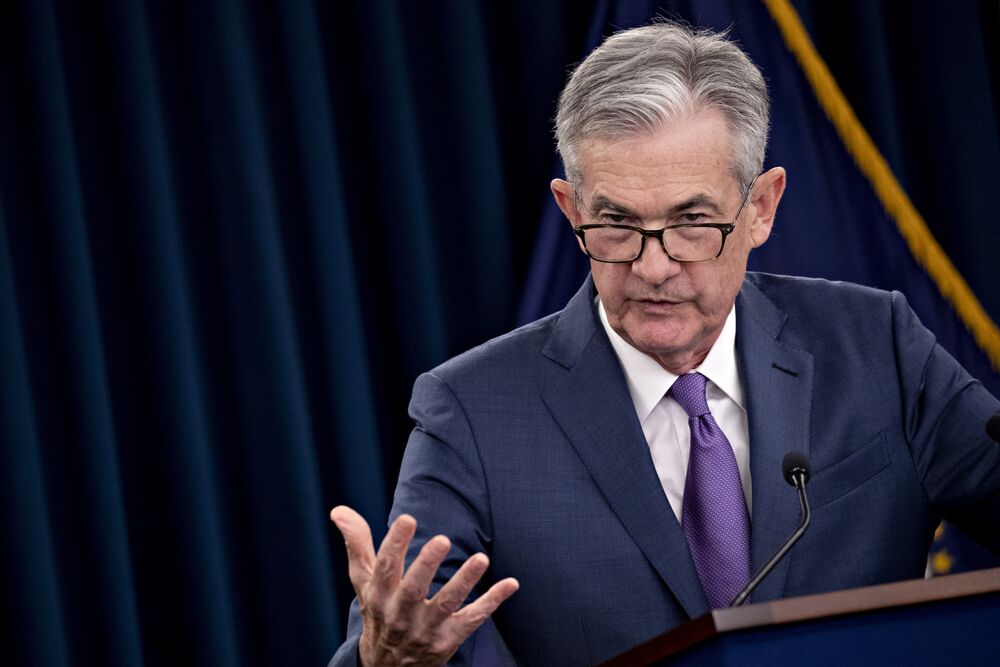
Federal Reserve Chairman Jerome Powell hearkened back to the central bank’s 1990’s policy successes by suggesting he can sustain the record long U.S. economic expansion with just a modest reduction in interest rates.
“We’re thinking of it as essentially in the nature of a mid-cycle adjustment to policy,” he said. A divided Fed lowered rates by a quarter percentage point, as had been widely expected.

Powell’s remark raised comparisons to 1995-96 and 1998, when Alan Greenspan headed the Fed. In each instance, the central bank ended up cutting rates three times in a successful effort to prolong an economic upswing that until this year was the longest.
Trump Ire
President Donald Trump also wasn’t pleased. “As usual, Powell let us down,” Trump said in a tweet. He had pressed the Fed to deliver a “large cut” in rates.
The central bank though did decide to stop shrinking its balance sheet -- something else Trump wanted.
If Powell succeeds with his strategy, that may end up being beneficial for investors, the president and -- the chairman made clear -- the American people, including many who are just starting to see the fruits of a super tight jobs market.
“There is really no reason why the expansion can’t keep going,” Powell said.
Insurance Cut
That’s what happened in the 1990’s.
“The intention is very much like 1995-96,” said Jonathan Wright, a Johns Hopkins University economics professor and a former Fed researcher. “Time will tell if it works out quite that way.” Those rate cuts extended that expansion into 2001.
There are a lot of comparisons between now and then. Back then, the Fed trimmed rates following an extended tightening cycle -- just as it began to do on Wednesday -- to prevent a slowing economy from stumbling into recession.
The rate cuts came in the year before a presidential election, though in 1995 it was Democrat Bill Clinton about to seek a second term, not Republican Trump.
Downside Risks
Powell gave three rationales for Wednesday’s move, which was opposed by Fed Reserve Bank Presidents Esther George and Eric Rosengren. Slowing global growth and elevated trade tensions are already hitting U.S. manufacturers. And there’s a risk that could get worse.
What’s more, inflation remains stubbornly below the Fed’s 2% objective.
“Continued below target inflation could lead to a worrisome and difficult-to-reverse downward slide in longer term expectations,” Powell said.
He denied that Trump’s repeated criticism of the Fed was behind Wednesday’s decision to cut rates. “We never take into account political considerations,” he said in response to a reporter’s question.
Trade Clouds
He did though say that the Fed was struggling over how to assess -- and respond to -- the impact of Trump’s trade policies on the economy.
“There isn’t a lot of experience in responding to global trade tensions,” he said. It’s “something that we haven’t faced before and that we’re learning by doing.”
While the direct effect of tariffs are not large, what’s key is the impact that the policies have on business confidence and financial markets, he said.
And they can change quickly in response to the latest Trump tweet.
In arguing that Wednesday’s small rate cut would aid the economy, Powell portrayed it as a continuation of a shift in the Fed’s posture, from projecting rate hikes in December to easing policy now.
“He was very much making the point that the Fed has changed its policy stance considerably,” said Wrightson ICAP LLC chief economist Lou Crandall.
The about-face has helped buttress financial markets and corporate confidence as it played out in recent months.
Muddled Message
Wednesday though was a different story, as investors and analysts grumbled over what they perceived as a muddled message.
The press conference “was a disaster,” Stephen Stanley, chief economist at Amherst Pierpont Securities LLC, said in a note to clients. “He repeatedly stammered and fell back on the language in the statement” issued by the Federal Open Market Committee.
In the end, though, after repeated questions from reporters, Powell delivered his bottom line.
“Let me be clear,” he said. “It’s not the beginning of a long series of rate cuts.”
But, he added, “I didn’t say it’s just one.”
